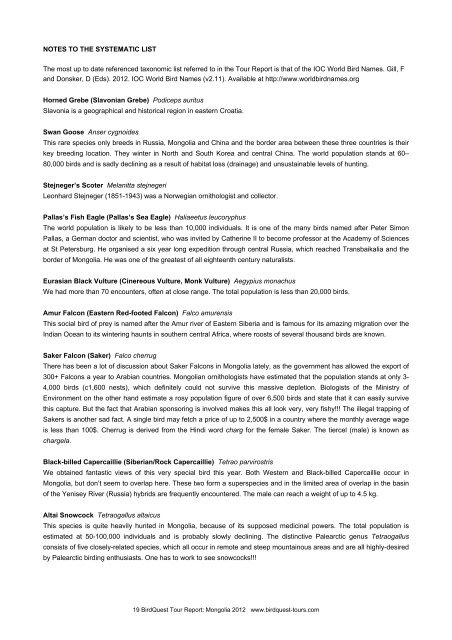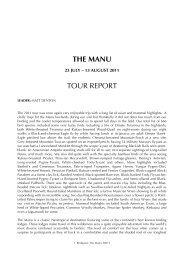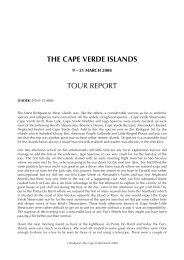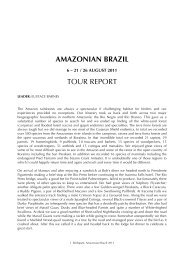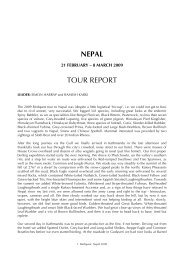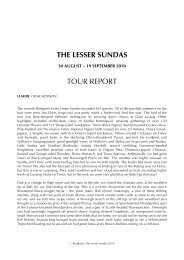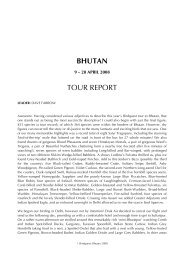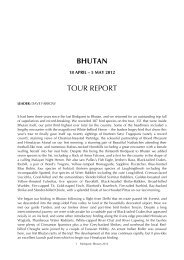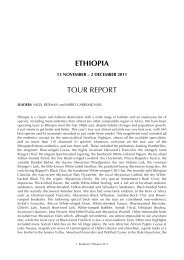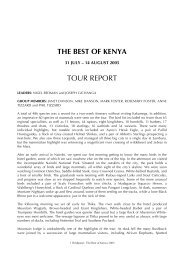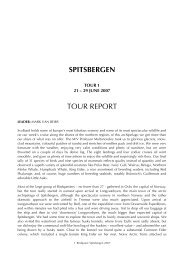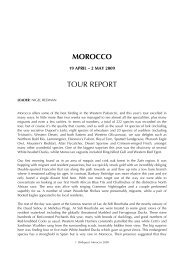MONGOLIA REP 12 - Birdquest
MONGOLIA REP 12 - Birdquest
MONGOLIA REP 12 - Birdquest
You also want an ePaper? Increase the reach of your titles
YUMPU automatically turns print PDFs into web optimized ePapers that Google loves.
NOTES TO THE SYSTEMATIC LIST<br />
The most up to date referenced taxonomic list referred to in the Tour Report is that of the IOC World Bird Names. Gill, F<br />
and Donsker, D (Eds). 20<strong>12</strong>. IOC World Bird Names (v2.11). Available at http://www.worldbirdnames.org<br />
Horned Grebe (Slavonian Grebe) Podiceps auritus<br />
Slavonia is a geographical and historical region in eastern Croatia.<br />
Swan Goose Anser cygnoides<br />
This rare species only breeds in Russia, Mongolia and China and the border area between these three countries is their<br />
key breeding location. They winter in North and South Korea and central China. The world population stands at 60–<br />
80,000 birds and is sadly declining as a result of habitat loss (drainage) and unsustainable levels of hunting.<br />
Stejneger’s Scoter Melanitta stejnegeri<br />
Leonhard Stejneger (1851-1943) was a Norwegian ornithologist and collector.<br />
Pallas’s Fish Eagle (Pallas’s Sea Eagle) Haliaeetus leucoryphus<br />
The world population is likely to be less than 10,000 individuals. It is one of the many birds named after Peter Simon<br />
Pallas, a German doctor and scientist, who was invited by Catherine II to become professor at the Academy of Sciences<br />
at St Petersburg. He organised a six year long expedition through central Russia, which reached Transbaikalia and the<br />
border of Mongolia. He was one of the greatest of all eighteenth century naturalists.<br />
Eurasian Black Vulture (Cinereous Vulture, Monk Vulture) Aegypius monachus<br />
We had more than 70 encounters, often at close range. The total population is less than 20,000 birds.<br />
Amur Falcon (Eastern Red-footed Falcon) Falco amurensis<br />
This social bird of prey is named after the Amur river of Eastern Siberia and is famous for its amazing migration over the<br />
Indian Ocean to its wintering haunts in southern central Africa, where roosts of several thousand birds are known.<br />
Saker Falcon (Saker) Falco cherrug<br />
There has been a lot of discussion about Saker Falcons in Mongolia lately, as the government has allowed the export of<br />
300+ Falcons a year to Arabian countries. Mongolian ornithologists have estimated that the population stands at only 3-<br />
4,000 birds (c1,600 nests), which definitely could not survive this massive depletion. Biologists of the Ministry of<br />
Environment on the other hand estimate a rosy population figure of over 6,500 birds and state that it can easily survive<br />
this capture. But the fact that Arabian sponsoring is involved makes this all look very, very fishy!!! The illegal trapping of<br />
Sakers is another sad fact. A single bird may fetch a price of up to 2,500$ in a country where the monthly average wage<br />
is less than 100$. Cherrug is derived from the Hindi word charg for the female Saker. The tiercel (male) is known as<br />
chargela.<br />
Black-billed Capercaillie (Siberian/Rock Capercaillie) Tetrao parvirostris<br />
We obtained fantastic views of this very special bird this year. Both Western and Black-billed Capercaillie occur in<br />
Mongolia, but don’t seem to overlap here. These two form a superspecies and in the limited area of overlap in the basin<br />
of the Yenisey River (Russia) hybrids are frequently encountered. The male can reach a weight of up to 4.5 kg.<br />
Altai Snowcock Tetraogallus altaicus<br />
This species is quite heavily hunted in Mongolia, because of its supposed medicinal powers. The total population is<br />
estimated at 50-100,000 individuals and is probably slowly declining. The distinctive Palearctic genus Tetraogallus<br />
consists of five closely-related species, which all occur in remote and steep mountainous areas and are all highly-desired<br />
by Palearctic birding enthusiasts. One has to work to see snowcocks!!!<br />
19 BirdQuest Tour Report: Mongolia 20<strong>12</strong> www.birdquest-tours.com


